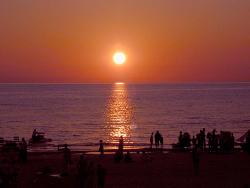Palanga
|
| Palanga is the place to be. It’s that simple. This little coastal village is completely
overbooked in the summers. The number of inhabitants grows tenfold, from 20,00 to 200,000 people. They sleep on
the beach, in the parks and the forests around. But the merchants and restaurant owners have all stored up and
do not complain. You really don’t have to go Majorca or any other place to get a tan when there is a place like
Palanga in Lithuania. They have infinite amounts of white sand, lots of restaurants, beer places, night clubs,
amusement parks, discos and other places where you can spend money. |
The holiday paradise unfolds
|
| Lie around in the sun and get burnt, ride a fast boat and intimidate all the bathers, party
all night, or meditate silently in a park or a church. You can do anything in and around Palanga. |
|
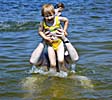
|
The water is warm and nice and not as disgustingly salty as the Mediterranean. The sun shone on this picture, at
least. |
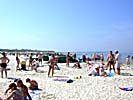
|
The sand doesn’t get whiter than this. People in the Baltics have understood this already. The place is popular. |
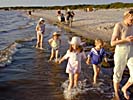
|
The beach is very long and you can walk in the shallow water and play with the kids. |
|
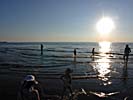
|
Ah! Another one of these pictures against the sun. |
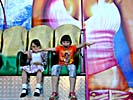
|
When you are tired of bathing, there are a few amusement parks to get you screaming. |
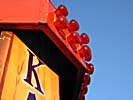
|
There are lots of places for the kids to go screaming, too. |
|
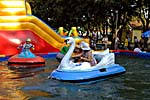
|
And then some quieter pleasures for kids who don’t enjoy four g’s all the time. |

|
Why not get out in the street and buy (below) |

|
If you get hungry and thirsty during the day, the town overflows with pizza places. The Lithuanian pizzas are a
wee bit better than the Swedish ones. |
|
...tourist stuff, things that you just got to have then, but have lost before next summer?
|
|

|
The town park is much quieter, some distance away from the screaming carousels and restaurant
entertainment. |
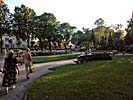
|
Palanga is a town made for taking walks. Have an ice cream and walk some more. |
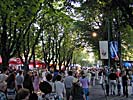
|
The broad streets with all the restaurants are always filled with happy people and barbecue smells are everywhere. |
|
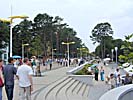
|
The amusement street, Basanavicius gatve has been spiced up and everuthing is top notch, except for the
hideous lampposts. The lamps are supposed to look like seagulls in flight. Perhaps, but why terribly yellow? One
might be forgiven for thinking that a company with large interests in Palanga and whose colour is yellow, the Svyturys
beer brewery, owning most of the beer tents in town, has had some say in it. The lamps are slightly lighter than
Svyturys yellow, or it would have been all too obvious. |
|
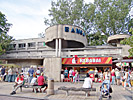
|
You’ll find a lot of strange tings along the Bsanavicius, such as the age-old Banga Restaurant (The Wave). |

|
The coolest an architect would dare during Soviet times. Raw concrete. We can smirk at it, now. |
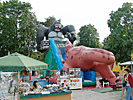
|
Inflatable amusement parks with two-storey monsters and King Kong’s. |
|

|
A tribute to the G forces effects on man. You can get yourself slingshot. |
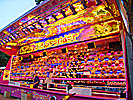
|
The lottery stands rumble, flash and smoke. Everything is shouting: “Spend!” |
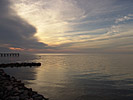
|
When it’s all too much, go down to the sea. It’s quiet there in the evenings. Except for the disco-beer-tents. |
|

|
But look out! There is another side to Palanga. There is art dangerously close by. You might
even forget the beach. |
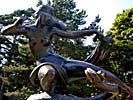
|
The statue shows the Lithuanian myth... (below) |

|
Then comes the night. If you’re getting tired, sit down, have a drink or by all means a hot dog Lithuanian style,
baked into the bread. |
|
...about Egle and Zilvinas the grass snake, a beloved tale. The snake’s head is all worn. Everyone
wants to be photographed in the statue.
|
|
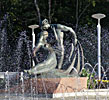
|
At the end of Basanavicius is the statue of Egle and Kastytis, two mythical figures. The kids climb in it all the
time, but it is... |
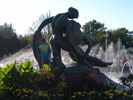
|
tolerated, just like everyone always wants to be photographed with Egle and Zilvinas. |
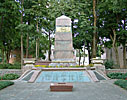
|
To our utter amazement we find a genuine Soviet war monument behind some bushes, with hammer and sickle. |
|
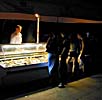
|
In the evening everyone goes wild, even wilder than during the day. Here a few tourists buy
smoked fish and have a beer. |
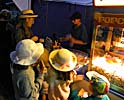
|
Vafliai, waffles with jam are very popular, too. |
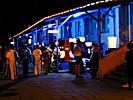
|
Don’t miss the game arcades. Pop music thumps heavily all around as people go crashing in the flight simulators. |
|
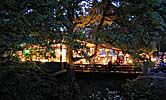
|
Let us finally have a look inside the restaurants. They are so tightly packed on Basanavicius that you can’t get
a knife-blade in between. |

|
This is yours truly in one of them, downing a beer. (below) |
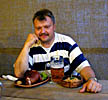
|
This is a happy guy enjoying a Lithuanian dish: the Karka, smoked pork leg with sauerkraut and a great big beer. |
|
The Lithuanian beer is so good that they really don’t have to import. One who understood this
and started his own brewery, and on top of this, serves the best food along the coast is Juozas
Food Palace, 4 kilometres from Palanga. Many thousands enjoy his wonderful Lithuanian food in sturdy, rustic
country environs every day. Juozas happens to be unbeatable.
But things have gone worse, or better, depending on how you look at it. Basanavicius street is
now a two-kilometre discotheque. If you want to dine quietly, you’ll have to wear earmuffs. The inhabitants also
complain about the noise, still it grows worse each year. Once a party town, always a party town.
|
Saying goodnight to the Sun
|
| At sunset each evening all the towns inhabitants suddenly start moving towards the beach
and out on the pier, to say goodnight to the Sun and to see it sinking into the sea. It’s a tradition deeply rooted
within the Lithuanians. They have been denied the sea for so long by various occupying powers. There is no pop
music and no one makes noise or fights. |
|
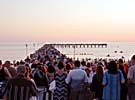
|
The lemmings well over the sand dunes and out on the pier. Someone may be quietly playing a guitar, but otherwise
everything is silent. |
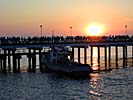
|
There are many ways to get to the pier’s end. Boating is one, pedal-boating another. Floating on a rubber mattress
is OK too. |
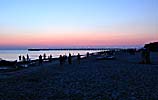
|
The pier viewed from the beach later at night. People have started going to sleep in the sand for the night. Did
you think there were hotels for all 200,000 of them? |
|
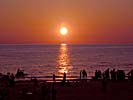
|
The ceremony begins. People look expectantly to the Sun that will soon sink into the sea. |

|
We go toward the pier’s end as the sun goes down. |
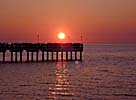
|
The pier is angled in the middle. You are supposed to go all the way out. |
|
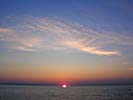
|
Now there’s not much left. Half of the sun is gone. |
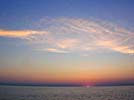
|
Now it’s only a tiny speck. Everyone says “Labanaktis”. |
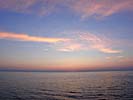
|
And it’s gone. As the sun is gone and all has greeted it, they walk slowly towards the beach again. |
|
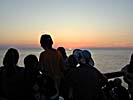
|
An idealised picture, perhaps, but this is the way holiday is supposed to be. |
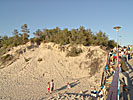
|
Unfortunately the beach is disappearing because some clever architects removed al lot of... |
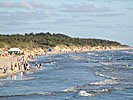
|
“old” stones under the pier in the beginning of the 90’s. Now it’s only a 5-metre strip left of the... |
|
...previously 100 metre wide beach. Hopefully, Sventoji will be spared
this fate.
|
Palanga Church
|
| The church is built from red brick, white on the inside with the red brick showing through
in a pattern. |
|

|
Nice. High. Pointy. |

|
As you walk through the gate is seems a little dark, but the church is cool and lovely after the summer heat outside. |

|
The church’s interior is high and nice and the windows make most of the light fall on the altar, while the rest
of the church is dark. That’s nice, too. |
|

|
Light falls in through the stained glass windows and makes fine patterns on the walls. |
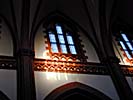
|
Ditto. The red brick pattern is more beautiful than if the walls would have been all white. |
Amber, the Baltic Transparent Gold
|
| The forests that once created the amber washed up on the Lithuanian beaches for thousands
of years, must have been unbelievably large. The stone, actually fossilised resin, occasionally with an embedded
insect can, if treated by a skilful artist, become very beautiful pieces of art. The real valuables are on the
Amber Museum. |
|

|
The amber is Lithuania. That’s it. Look though a well-formed stone and see Lithuania. Buy it and take Lithuania
home! |
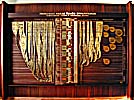
|
“What the fossils tell about the world’s development”, one of the finest time-lines I have ever seen, made in brass
and wood at the Amber Museum. |

|
A case with some giant lumps. It wasn’t easy to make pictures, as it was prohibited. I had to be fast about it. |
|
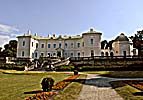
|
The museum was once a palace of Count Tiskevicius, until Communism. Then he snipped off to the west with his family. |
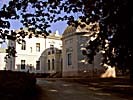
|
The palace from the side. |
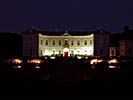
|
In the night it is nicely floodlit. |
|
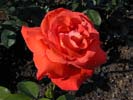
|
Behind the museum is a rose garden... |
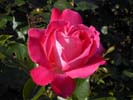
|
with the most wondrous sorts of roses... |
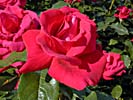
|
...and here’s another. |
The Sobor Outside Palanga
|
| This church, a Russian-Orthodox sobor called “Ivera, icon of God's Mother” is situated right outside Palanga
along the north-south coast highway. Usually you drive right past it, perhaps admiring the gleaming onion-shaped
dome, but no more. Regrettingly, because there are no sour ladies inside, preventing you from making pictures.
Although this is not a place the Lithuanians visit all that often. |
|

|
This parish seems to very rich, just a little too rich. The onion dome must be the shiniest in
the history of onion domes. Normally the sobors are not this wealthy and one might be forgiven to think that they
get their money from “somewhere” to show continued Russian presence in the present day capitalistic Palanga.
|

|
|
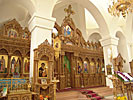
|
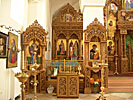
|
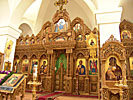
|
The icnonostase is overwhelming. The haven’t saved on the gold leaf. All the holies look down
on us, mass-produced.
|
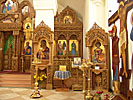
|
|
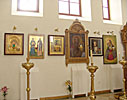
|
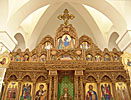
|
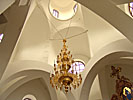
|
Everything is top top. No cracks, no damp-stains.
|
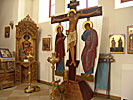
|
|

|
 
|

|
The icons are newly varnished without cracks. Look close. They are very beatutiful. The one to
the left is quite fantastic!
|

|
|
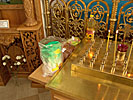
|
This is the fist time I have seen food offerings in Lithuania. It is rice, bread, goodies and oil. |
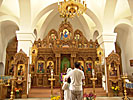
|
There’s a small shop too, where you can buy incense and icons. Just check the rules for exporting
icons.
|
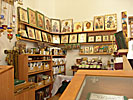
|
|
